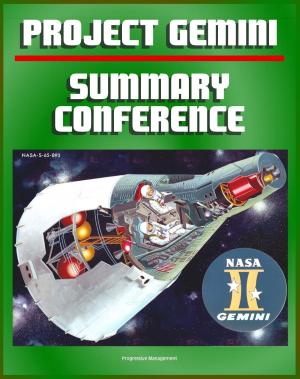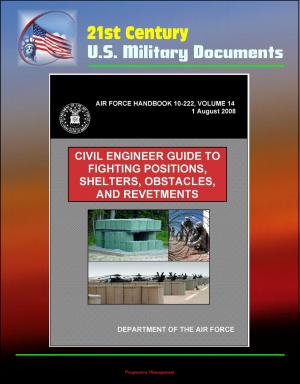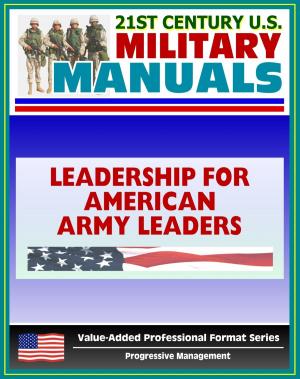Interagency Standards for Fire and Fire Aviation Operations: Federal Wildland Fire Management Policy, Safety, Risk Management, Chemicals and Delivery Systems, Firefighting Training and Equipment
Nonfiction, Science & Nature, Technology, Fire Science| Author: | Progressive Management | ISBN: | 9781310112409 |
| Publisher: | Progressive Management | Publication: | March 16, 2015 |
| Imprint: | Smashwords Edition | Language: | English |
| Author: | Progressive Management |
| ISBN: | 9781310112409 |
| Publisher: | Progressive Management |
| Publication: | March 16, 2015 |
| Imprint: | Smashwords Edition |
| Language: | English |
Professionally converted for accurate flowing-text e-book format reproduction, this is an important government publication with Interagency Standards for Fire and Fire Aviation Operations, states, references, or supplements policy for Bureau of Land Management, Forest Service, Fish and Wildlife Service, and National Park Service fire and fire aviation program management.
Chapter 01 - Federal Wildland Fire Management Policy Overview * Chapter 02 - BLM Program Organization and Responsibilities * Chapter 03 - NPS Program Organization and Responsibilities * Chapter 04 - FWS Program Organization and Responsibilities * Chapter 05 - FS Program Organization and Responsibilities * Chapter 06 - Reserved * Chapter 07 - Safety and Risk Management * Chapter 08 - Interagency Coordination and Cooperation * Chapter 09 - Fire Management Planning * Chapter 10 - Preparedness * Chapter 11 - Incident Management * Chapter 12 - Suppression Chemicals and Delivery Systems * Chapter 13 - Firefighting Training and Qualifications * Chapter 14 - Firefighting Equipment * Chapter 15 - Communications * Chapter 16 - Aviation Operations and Resources * Chapter 17 - Fuels Management * Chapter 18 - Reviews and Investigations * Chapter 19 - Dispatch and Coordination System
Guiding Principles of the Federal Wildland Fire Management Policy - 1. Firefighter and public safety is the first priority in every fire management activity. 2. The role of wildland fire as an essential ecological process and natural change agent will be incorporated into the planning process. Federal agency land and resource management plans set the objectives for the use and desired future condition of the various public lands. 3. Fire Management Plans (FMPs), programs, and activities support Land and Resource Management Plans and their implementation. 4. Sound risk management is a foundation for all fire management activities. Risks and uncertainties relating to fire management activities must be understood, analyzed, communicated, and managed as they relate to the cost of either doing or not doing an activity. Net gains to the public benefit will be an important component of decisions. 5. Fire management programs and activities are economically viable, based upon values to be protected, costs, and land and resource management objectives. Federal Agency Administrators are adjusting and re-organizing programs to reduce costs and increase efficiencies. As part of this process, investments in fire management activities must be evaluated against other agency programs in order to effectively accomplish the overall mission, set short and long term priorities, and clarify management accountability. 6. FMPs and activities are based upon the best available science. Knowledge and experience are developed among all wildland fire management agencies. An active fire research program combined with interagency collaboration provides the means to make these tools available to all fire managers. 7. FMPs and activities incorporate public health and environmental quality considerations.
Professionally converted for accurate flowing-text e-book format reproduction, this is an important government publication with Interagency Standards for Fire and Fire Aviation Operations, states, references, or supplements policy for Bureau of Land Management, Forest Service, Fish and Wildlife Service, and National Park Service fire and fire aviation program management.
Chapter 01 - Federal Wildland Fire Management Policy Overview * Chapter 02 - BLM Program Organization and Responsibilities * Chapter 03 - NPS Program Organization and Responsibilities * Chapter 04 - FWS Program Organization and Responsibilities * Chapter 05 - FS Program Organization and Responsibilities * Chapter 06 - Reserved * Chapter 07 - Safety and Risk Management * Chapter 08 - Interagency Coordination and Cooperation * Chapter 09 - Fire Management Planning * Chapter 10 - Preparedness * Chapter 11 - Incident Management * Chapter 12 - Suppression Chemicals and Delivery Systems * Chapter 13 - Firefighting Training and Qualifications * Chapter 14 - Firefighting Equipment * Chapter 15 - Communications * Chapter 16 - Aviation Operations and Resources * Chapter 17 - Fuels Management * Chapter 18 - Reviews and Investigations * Chapter 19 - Dispatch and Coordination System
Guiding Principles of the Federal Wildland Fire Management Policy - 1. Firefighter and public safety is the first priority in every fire management activity. 2. The role of wildland fire as an essential ecological process and natural change agent will be incorporated into the planning process. Federal agency land and resource management plans set the objectives for the use and desired future condition of the various public lands. 3. Fire Management Plans (FMPs), programs, and activities support Land and Resource Management Plans and their implementation. 4. Sound risk management is a foundation for all fire management activities. Risks and uncertainties relating to fire management activities must be understood, analyzed, communicated, and managed as they relate to the cost of either doing or not doing an activity. Net gains to the public benefit will be an important component of decisions. 5. Fire management programs and activities are economically viable, based upon values to be protected, costs, and land and resource management objectives. Federal Agency Administrators are adjusting and re-organizing programs to reduce costs and increase efficiencies. As part of this process, investments in fire management activities must be evaluated against other agency programs in order to effectively accomplish the overall mission, set short and long term priorities, and clarify management accountability. 6. FMPs and activities are based upon the best available science. Knowledge and experience are developed among all wildland fire management agencies. An active fire research program combined with interagency collaboration provides the means to make these tools available to all fire managers. 7. FMPs and activities incorporate public health and environmental quality considerations.















